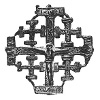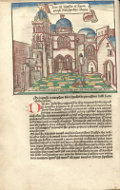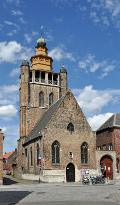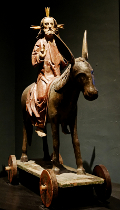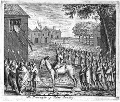Commemoration of the Jerusalem pilgrimage
Many pilgrims wanted to commemorate their pilgrimage. They had various motives: on the one hand, there was the desire for personal remembrance. On the other hand, the pilgrimage awarded great social prestige to the traveller. Also, a foundation, donation, or the collection of relics could enhance the positive effect of the pilgrimage, or made others benefit from it. These motives caused a variety of commemorative practices to emerge.
Insignia and medals
Firstly, there were the more 'personal' keepsakes, such as pilgrim's insignia, souvenirs, and commemorative medals. Moreover, with these signs one could show others that one was a Jerusalem pilgrim or even a knight of the Holy Sepulchre. Also, some sources mention that some pilgrims had a commemorative tattoo.1
Travel reports
Written reports of the journey have survived in large quantities. These texts were written for various reasons. As a personal memory, as a travel guide for pilgrims-to-be, or as a 'spiritual pilgrimage' for the armchair traveller who could or would not make the pilgrimage.2 They usually consist of not more than a list of the holy places and indulgences, but now and then they provide practical information or personal experiences as well. A well-known example of such a report is that of the Mainz canon Bernhard von Breydenbach, originally devised as a guide for a fellow pilgrim, later (1486) published for a broader public with woodcut illustrations by the Utrecht artist Erhard Reuwich.
Foundations
Foundations of chapels, altars, and 'hofjes' (courts of almshouses) were often made. These combined the commemoration of the journey, care for the souls, charity, and social prestige for the founder(s). The Adornes family from Bruges, for example, founded a Jerusalem chapel with adjacent almshouses in the middle of the fifteenth century, which commemorated the Jerusalem pilgrimages made by members of the family and emphasized the family's importance for the city.3
In various Dutch cities, 'hofjes' were created for the poor or the elderly by pilgrims who returned from the Holy Land. They were given names such as 'Jeruzalemshofje' or 'Sionshofje',4 Moreover, these foundations could serve as a personal burial place: Gijsbert Raet, for example, the founder of the Gouda Jerusalem chapel, was buried in his own chapel. Chapels such as this one were often built with a circular ground plan, an echo of the Church of the Holy Sepulchre, or contained a model of the Sepulchre. This is a phenomenon that could be seen all around Europe from the twelfth century onwards.5
Jerusalem confraternities
A characteristic Netherlandish commemorative practice was the creation of confraternities of Jerusalem pilgrims. These were religious associations, mainly concerned with care for the souls, which held a common meal once a year. Besides, the Jerusalem confraternities (except the one in Paris) had the special task to accompany the donkey carrying Christ during the procession on Palm Sunday, as a reminder of his entry in Jerusalem. During this ceremony, the members of the confraternity carried palm branches, which made them recognizable for others as Jerusalem pilgrims.6
The special entrance requirement for the confraternities of Jerusalem pilgrims was that one had to be a Jerusalem pilgrim, or at least have the intention to become one. In Utrecht, for example, pilgrims-to-be could acquire membership as well, though not full membership. In this exclusivity the Jerusalem confraternities were different from other confraternities and they therefore had great social prestige. In some cities (Utrecht, Dordrecht) it was possible for women to enter the confraternity as well.7
The first Jerusalem confraternity originated in Paris around 1320, originally with a crusading purpose. Quickly, though, this idea faded and a more peaceful ideal of pilgrimage was emphasized. In 1394 Utrecht followed suit, and during the fifteenth and sixteenth centuries so did many other cities in the Netherlands. The phenomenon has not been found to occur outside the Netherlands or Paris. The decline in interest for the pilgrimage and the Reformation in the sixteenth century meant the end for many confraternities. Only in Antwerp was the idea revived in its original form during the seventeenth century.8
Previous: The grand pilgrimage, 1333-1600
Next: Portraits of Jerusalem pilgrims
- Wim Cerutti, Haarlemse Jeruzalemvaarders (Haarlem 2010), pp. 61-62.
- Ganz-Blättler, Andacht und Abenteuer: Berichte europäischer Jerusalem- und Santiago-Pilger (1320-1520) (Tübingen 1990).
- Dikken, Charlotte, 'A Monument to a Glorious Past and a Questionable Future? The Jerusalem Chapel in Bruges and its Stained Glass Windows', in Rolf de Weijert et al. (eds.), Living Memoria. Studies in Medieval and Early Modern Memorial Culture (Hilversum 2011), pp. 79-96.
- Schneider, Wolfgang, Peregrinatio Hierosolymitana. Studien zum spätmittelalterlichen Jerusalembrauchtum und zu den aus der Heiliglandfahrt hervorgegangenen nordwesteuropäischen Jerusalembruderschaften (Münster 1982), pp. 178-179.
- Morris, Colin, The Sepulchre of Christ and the Medieval West. From the Beginning to 1600 (Oxford 2005), pp. 230-244, 328-362.
- Schneider, Peregrinatio Hierosolymitana, p. 138.
- Ibid., p. 165.
- Ibid., p. 203.
